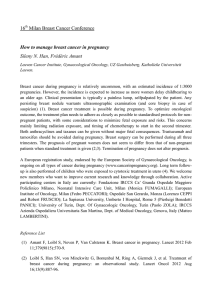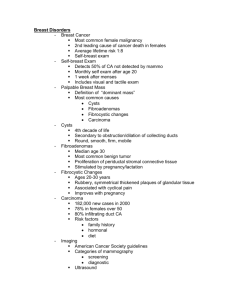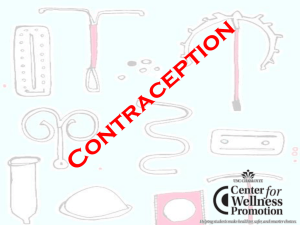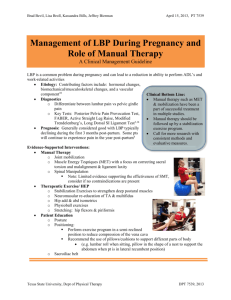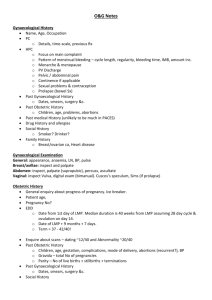O&G Learning Outcomes
advertisement
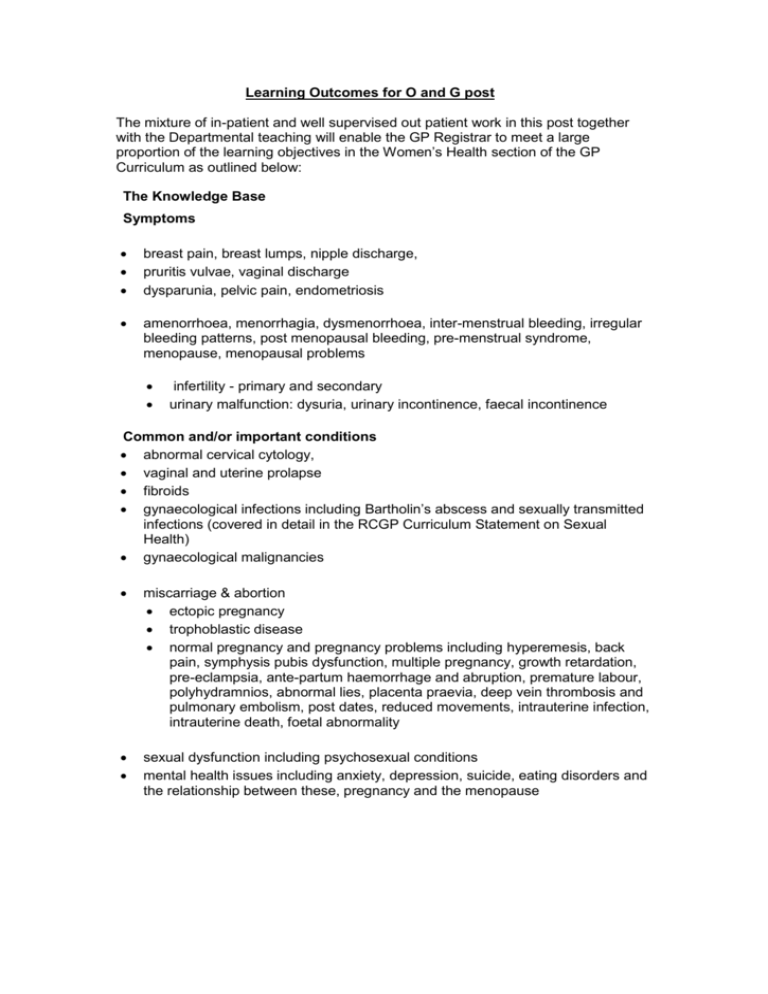
Learning Outcomes for O and G post The mixture of in-patient and well supervised out patient work in this post together with the Departmental teaching will enable the GP Registrar to meet a large proportion of the learning objectives in the Women’s Health section of the GP Curriculum as outlined below: The Knowledge Base Symptoms breast pain, breast lumps, nipple discharge, pruritis vulvae, vaginal discharge dysparunia, pelvic pain, endometriosis amenorrhoea, menorrhagia, dysmenorrhoea, inter-menstrual bleeding, irregular bleeding patterns, post menopausal bleeding, pre-menstrual syndrome, menopause, menopausal problems infertility - primary and secondary urinary malfunction: dysuria, urinary incontinence, faecal incontinence Common and/or important conditions abnormal cervical cytology, vaginal and uterine prolapse fibroids gynaecological infections including Bartholin’s abscess and sexually transmitted infections (covered in detail in the RCGP Curriculum Statement on Sexual Health) gynaecological malignancies miscarriage & abortion ectopic pregnancy trophoblastic disease normal pregnancy and pregnancy problems including hyperemesis, back pain, symphysis pubis dysfunction, multiple pregnancy, growth retardation, pre-eclampsia, ante-partum haemorrhage and abruption, premature labour, polyhydramnios, abnormal lies, placenta praevia, deep vein thrombosis and pulmonary embolism, post dates, reduced movements, intrauterine infection, intrauterine death, foetal abnormality sexual dysfunction including psychosexual conditions mental health issues including anxiety, depression, suicide, eating disorders and the relationship between these, pregnancy and the menopause Investigations To develop an understanding and be able to perform and interpret Pregnancy testing urinalysis, MSU and urine dipstick blood tests including renal function tests, hormone tests bacteriological and virology tests knowledge of secondary care investigations including colposcopy and sub fertility investigations Treatment primary care management of the conditions listed above menopause management including Hormone Replacement Therapy knowledge of specialist treatments and surgical procedures including: laparoscopy, D&C, hysterectomy, oopherectomy, ovarian cystectomy, pelvic floor repair, medical and surgical termination of pregnancy, sterilisation understand the risks of prescribing during pregnancy Emergency Care bleeding in pregnancy suspected ectopic pregnancy domestic violence Prevention health education regarding lifestyle and sexual and mental health pre pregnancy issues discontinuing contraception, folic acid, family & genetic history and lifestyle advice pregnancy care including health promotion, social and cultural factors, smoking and alcohol, age factors, previous obstetric history, diabetes and obesity, rhesus problems and use of anti d, hypertension and other medical problems, anaemia, acid reflux, leg ache and varicose veins, haemorrhoids, rubella testing and immunisation Risk assessment, screening and management of osteoporosis Person-centred Care Communicate sensitively with women about sexuality and intimate issues (particularly in recognising the impact of past sexual abuse and genital mutilation) Recognise that many women consult for lifestyle advice, and that GPs should not over-medicalise these issues Recognise the issues of gender and power, and the patient-doctor relationship, and know how to prevent these issues adversely affecting women's health care Recognise the needs of lesbian or bisexual women i.e. understand that the partners of some women are women and understand the need not to make assumptions such as the need for contraception Describe the importance of confidentiality and informed consent Describe the issues relating to the use of chaperones Describe the impact of gender on individual cognition and lifestyle, and formulate strategies for responding to this. For example, some women, such as those from low socio-economic groups, or living with an addiction, may have limited control over lifestyle choices. Detect whether the female patient wishes to see a doctor of the same sex and arrange this where practical and appropriate. Specific Problem-Solving Skills Demonstrate a reasoned approach to the diagnosis of women’s symptoms in a manner that is comfortable for both the patient and the GP using history, examination, incremental investigations and refer appropriately Recognise the prevalence of domestic violence and question sensitively where this may be an issue Intervene urgently with suspected malignancy and have a low threshold for the referral of breast lumps Recognise and intervene immediately when patients present with a gynaecological emergency Demonstrate an understanding of the importance of risk factors in the diagnosis and management of women’s problems. A Comprehensive Approach Outline screening strategies relevant to women (e.g. cervical, breast, other cancers, postnatal depression) and discuss their advantages/disadvantages; Outline prevention strategies relevant to women (e.g. safer sex, pre-pregnancy counselling, antenatal care, immunisation, osteoporosis) Understand the importance of promoting health and a healthy lifestyle in women, and in particular the impact of this on the unborn child, growing children and the family Understand the impact of other illness, in both the patient and her family on the presentation and management and of women’s health problems. Community Orientation Understand the issues of equity and access to health information and services for women Evaluate the effectiveness of the primary care service you provide from the female patient’s point of view. Appraise the role of well-woman clinics in primary care. A Holistic Approach Discuss the psycho-social component of women's health and the need, in some cases, to provide women patients with additional emotional and organisational support (e.g. in relation to pregnancy options, hormone replacement therapy, breast cancer, and unemployment) Contextual Aspects Be familiar with legislation relevant to women's health (e.g. abortion, contraception for minors) Attitudinal Aspects Recognise their own values, attitudes and approach to ethical issues (e.g. abortion, contraception for minors, consent, confidentiality, cosmetic surgery) Describe the impact of culture and ethnicity on women’s perceived role in society and their attendant health beliefs, and tailor healthcare accordingly Scientific Aspects Be aware of tensions between science and politics of screening Describe and implement the key national guidelines that influence healthcare provision for women’s problems (and note that the documents will vary across the UK following devolution) Psychomotor Skills Perform a gentle and thorough pelvic examination, including, digital and speculum examination, assessment of the size, position and mobility of the uterus and the recognition of abnormality of the pelvic organs paying attention to professional etiquette, patient consent, comfort and information Competently perform a cervical smear with sensitivity and care, providing a positive, informative experience for the woman that allows her to control the process and enhances her view of herself and her body. Perform a competent and sensitive breast examination, paying attention to explanation, informed consent, professional etiquette and comfort Catheterisation Change a ring pessary



